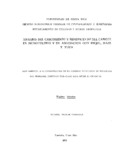| dc.contributor.author | Escobar Carranza, Ricardo | |
| dc.contributor.other | CATIE - Centro Agronómico Tropical de Investigación y Enseñanza | |
| dc.coverage.spatial | Turrialba, Costa Rica | |
| dc.date.accessioned | 2014-10-20T04:07:14Z | |
| dc.date.available | 2014-10-20T04:07:14Z | |
| dc.date.issued | 1975 | es_ES |
| dc.identifier | 342602 | es_ES |
| dc.identifier.uri | https://repositorio.catie.ac.cr/handle/11554/4461 | |
| dc.description | Tesis (Mag. Sc.) -- CATIE, Turrialba (Costa Rica) -- UCR, San José (Costa Rica), 1975 | es_ES |
| dc.description.abstract | Los objetivos de este estudio fueron analizar el crecimiento y el rendimiento del camote var. C-15 en monocultivo y en asociación con frijol, maíz y yuca y categorizar las asociaciones por su influencia sobre el crecimiento y rendimiento de dicha variedad. Los tratamientos fueron cinco formas de asociación: camote en monocultivo, camote asociado con frijol, con maíz, con yuca y una triple asociación de camote, maíz y frijol. Además, la determinación de la longitud y diámetro del tallo central y de razones entre pesos secos de hojas, raíces y parte aérea. El análisis del rendimiento incluyó la determinación del peso y número de tubérculos por planta y el rendimiento de tubérculos por hectárea. Del análisis de la información se concluye que la asociación del camote con otras especies produce principalmente un retraso en su crecimiento y tuberización. El maíz muestra los efectos más perjudiciales en el crecimiento del camote comparado con el frijol y la yuca. Los rendimientos del camote están correlacionados con su patrón de crecimiento vegetativo, sin embargo, se encontró que en general, las tendencias de crecimiento fueron similares en todas las situaciones, pero el incremento periódico de biomasa tiende a ser cuantitativamente menor en los cultivos asociados. La longitud del tallo central no es una medida que representa bien el crecimiento del camote, ya que fue igual para todos los tratamientos a la edad de 60 y 90 días, además, es un parámetro de difícil determinación en especial para variedades como la C-15 de crecimiento indeterminado. | es_ES |
| dc.description.abstract | The objectives of this study were to analyze the growth and yield of the C-15 sweet potato variety grown as monoculture and in association with beans, corn and cassava, and to classify the associations by its influence on the growth and yield of that variety. The treatments were: sweet potato fin monoculture (SP), sweet potato associated with beans (SP + &), with corn (SP + C), with cassava (SP + Ca), and a triple association with sweet potato, corn and beans (SP + C + 8). The data was obtained through periodic samplings of a great number of plants grown in plots with an area of 90 m2, in an experiment of randomized blocks. The comparisons between variables were made by "t” tests. From the analysis of the data it was concluded that the association of sweet potato plants with the other species produced a retardment of its growth and tuberization., The associations SP + B and SP + Ca permited a growth of the sweet potato plants similar to that of the monoculture in terms of periodic increase of biomass in its organs. Corn produced detrimental effects on the growth of sweet potato plants in comparison with that of beans and cassava. sweet potato yields were correlated with the growth pattern of the plants, nevertheless it was found that the growth tendencies were similar in all associations but periodic increments in biomass tended to diminish when the plants are grown in association with the other species. | |
| dc.format.extent | 101 páginas | |
| dc.language.iso | es | es_ES |
| dc.publisher | Universidad de Costa Rica, San José (Costa Rica) | es_ES |
| dc.publisher | Centro Agronómico Tropical de Investigación y Enseñanza (CATIE) | |
| dc.subject | COSTA RICA | |
| dc.subject | RENDIMIENTO | |
| dc.subject | YUCA | |
| dc.subject | MAÍZ | |
| dc.subject | IPOMOEA BATATAS | |
| dc.subject | MONOCULTURE | |
| dc.subject | INTERCROPPING | |
| dc.subject | PLANT DEVELOPMENTAL STAGES | |
| dc.subject | YIELDSPHASEOLUS VULGARIS | |
| dc.subject | IPOMOEA BATATAS | |
| dc.subject | ZEA MAYS | |
| dc.subject | MANIHOT ESCULENTA | |
| dc.subject | RENDIMIENTO | |
| dc.subject | MONOCULTIVO | |
| dc.subject | CULTIVO INTERCALADO | |
| dc.subject | ETAPAS DE DESARROLLO DE LA PLANTA | |
| dc.title | Análisis del crecimiento y rendimiento del camote en monocultivo y en asociación con frijol, maíz y yuca | es_ES |
| dc.type | Tesis | es_ES |
| dcterms.rights | acceso abierto | |
| dc.status | info:eu-repo/semantics/openAccess | |


